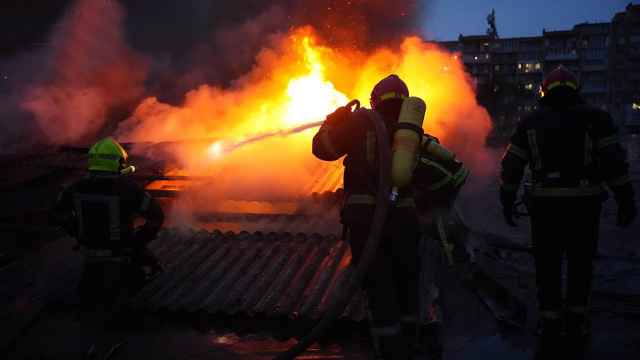With news of military escalation, civilian evacuation, and humanitarian catastrophe – plus an assurance from the Ukrainian Commander-in-chief that the situation was “100-percent under control” – it was hardly surprising that many in Kiev began talking about a “second Debaltseve.”
That bloody battle, which culminated two years ago this month, saw the Ukrainian army come under crippling, Russian-backed firepower, before withdrawing. The humiliating losses forced Ukraine to accept the end of its ambitions to retake occupied territories militarily.
This latest fighting flared up on Jan. 29 in a notoriously hot zone northeast of Donetsk airport. It is, without doubt, the most serious fighting in the region for over a year.
What we know is that the Ukrainian-held town of Avdiivka suffered the most — with dozens of heavy missiles landing in residential areas, numerous civilian injuries, one civilian death, and seven military deaths. According Eduard Basurin, a spokesman for the opposing side, separatist fighters also suffered casualties, including five killed in action.
What happened in the days before is murkier.
Both sides have been guilty of pulling at the edges of the Minsk peace deal. Finalised during the Debaltseve endgame, the agreement sets out weapon and troop withdrawal, alongside new election regimes, prisoner exchanges and border transfers. Since its signing, the agreement has seemed quixotic in its aims, and in recent months the reality gap has only widened.
In the immediate run-up to the fighting, OSCE special monitoring reports documented a series of violations. Weapon systems and troops on both sides have been doing things they shouldn’t, and doing those things where they shouldn’t. In particular, the monitoring mission observed incursions by Ukrainian troops into “grey” demilitarised zones.
Less contested than who started it is the humanitarian disaster that now threatens Avdiivka’s 8,000 residents. With the mercury at minus 16 degrees Celcius, much of the town is without electricity and communications lines. Parts of Avdiivka are without heating, owing to problems at the coking plant to the north of the city, the largest in Europe, which usually provides the town’s heating. An evacuation operation has begun. Depending on whether crucial infrastructure can be successfully repaired, it might extend to the majority of the population.
Speaking by phone to the Moscow Times on Wednesday, Feb. 1, the manager of the Avdiivka coking plant, Musa Magomedov, said that the situation remained critical. No missiles had landed inside the coking plant itself, but they had affected its electricity supply, while “grad missiles continue to fly into residential sectors of the old town.”
At press time, negotiations were underway to arrange access to damaged electricity lines. The future of the frontline plant and its 3,800 workers remained under question, Magomedov said.
“Sometimes you think that’s it — we’re finished,” he said.
The immediate political context provides a number of possible theories as to motive. Most focus on Trump's unexpected presidency.
On the one hand, Ukraine fears being dumped by its one-time closest ally, and, so that logic goes, wanted to force a military upsurge and move the new U.S. administration away from any notions of sanctions relief. On Tuesday, Dec. 31, Ukrainian President Petro Poroshenko released a video arguing exactly this. “Who would dare talk about lifting the sanctions in such circumstances?” he said.
Others note that the fighting happened shortly after the first phone conversation between Presidents Putin and Trump. Had the Russians been given assurances, felt emboldened by the prospects of a new start, or simply wanted to send a salvo over to the new administration?
Whatever happens in the coming days and weeks, neither side is likely aiming for territorial gains. Since winter 2015, Ukrainian and separatist positions have been so heavily fortified that significant offensive movement offers only diminishing returns.
Occasional, lethal skirmishes, however, offer more tactical promise. Both sides, we know, are unhappy with the status quo provided by Minsk. Russia meanwhile would only relish the opportunity to ratchet up pressure on a regime in Kiev it views as unfriendly.
A Message from The Moscow Times:
Dear readers,
We are facing unprecedented challenges. Russia's Prosecutor General's Office has designated The Moscow Times as an "undesirable" organization, criminalizing our work and putting our staff at risk of prosecution. This follows our earlier unjust labeling as a "foreign agent."
These actions are direct attempts to silence independent journalism in Russia. The authorities claim our work "discredits the decisions of the Russian leadership." We see things differently: we strive to provide accurate, unbiased reporting on Russia.
We, the journalists of The Moscow Times, refuse to be silenced. But to continue our work, we need your help.
Your support, no matter how small, makes a world of difference. If you can, please support us monthly starting from just $2. It's quick to set up, and every contribution makes a significant impact.
By supporting The Moscow Times, you're defending open, independent journalism in the face of repression. Thank you for standing with us.
Remind me later.






